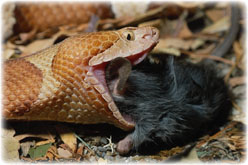Snake Feeding and Digestion
| This article is still under construction. |
All snakes are carnivores. With over 2900 different species, some snakes have highly specialised diets (eggs, lizards, frogs, fish, fish eggs or invertebrates such as slugs or termites) while others are generalists and will eat a wide variety of prey items. Common pet snakes such as rat snakes, milk snakes boas and pythons typically feed on rodents but some pet and many exhibition snakes require special diets. It is therefore necessary to have species-specific information to determine the most appropriate prey.
Size and type of prey
- The size of the prey can be about the same diameter as the snake's head
The feeding of whole prey is similar to a snake's diet in the wild. The feeding of pieces of prey (e.g. fish off-cuts to garter snakes) can lead to diet related diseases. In general, since snakes eat whole animals, nutritional problems are relatively uncommon.
- Aquatic species usually prefer fish and amphibian prey items
- Arboreal snakes usually prefer avian and reptilian prey items
- Terrestrial snakes will readily accept different prey items
Frequency of feeding
- Young, growing snakes may require food every 2 to 3 days
- Active snakes such as garter snakes require several feeds per week
- Small adult snakes may eat weekly or more often
- Giant snakes may only eat 4 to 6 times yearly
- Snakes may not feed during ecdysis
- Some snakes do not feed during the breeding season
Royal python
- Environmental cues can be important for feeding. A royal python is far more likely to eat a rodent that is similar in colour to agouti coloured free-living rodents. In captivity these snakes are often offered albino or fancy coloured mice rather than appropriately coloured prey and therefore do not receive the visual cues to eat.
Garter snake
- The presence of thiaminases in frozen fish can lead to clinical disease in fish-eating snakes, such as garter snakes.
Feeding live prey
Because snakes hunt using olfactory senses, they can be easily trained to accept euthanised prey. It is not recommended to feed live prey for several reasons:
- Excessive stress to the prey because of the environment
- Injuries to the snake from the prey
- Illegal in the U.K.
- Food items should be humanely euthanised using carbon dioxide or cervical dislocation
